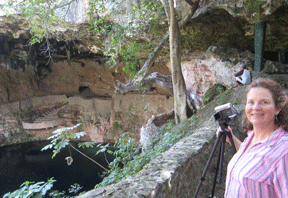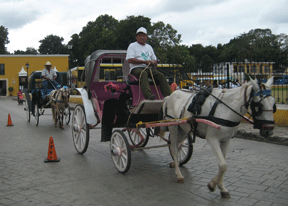Videotaping Zaci Cenote in Valladolid, Yucatan, Mexico
Here I am videotaping the cenote, or sinkhole, in Valladolid, Yucatan, Mexico. This Valladolid cenote, called Zaci, is featured in the Yucatan Travel Movie. There are many of these sinkholes throughout the state of Yucatan and its nearby state of Quintana Roo. The fresh water within the cenotes provided water for the indigenous Mayan people, because the northern Yucatan Peninsula does not have rivers, streams, or lakes–no surface water. Rainwater trickles down through the limestone earth of the northern Yucatan Peninsula to form underwater rivers. The cenotes provide openings to the underwater rivers. I love the deep turquoise color of the water. Continue reading
Cenote Swimmer in Yucatan
Zaci Cenote appears in the Yucatan Travel Movie. Here, I am looking at a woman below me who is looking at a swimmer below her in the beautiful turquoise-green water of the cenote. Cenotes formed millions of years ago when sinkholes formed in the thick limestone surface exposing underground rivers below. This cenote, called “Zaci,” the original name of the city in which it is found, is in Valladolid, an inland city west of Cancun. Continue reading
Izamal Horse &Buggy Taxis and Apparitions of the Virgin Mary
When traveling in Yucatan earlier this month, we visited one of my favorite Colonial cities, the lovely town of Izamal. Early December is the perfect time to be there, because the town celebrates a many-day-long festival in honor of “Concepcion,” a statue of the Virgin Mary who is the patron saint of the state of Yucatan. Supposedly, she has amazing healing powers. Hundreds of thousands of people come to Izamal in December to honor “Concepcion.” In fact, Izamal is the site of an apparition of the Virgin Mary involving this lovely statue. We were able to shoot some supplemental footage that will be useful in future movies. Izamal is already included in the Yucatan Travel Movie. Continue reading
The Rutting Season
Last night, while driving home in the dark, a buck leaped across the road in front of my car. Fortunately, my “hockey reflexes” kicked in. I quickly but lightly braked so the SUV behind me didn’t ram into my vehicle. The deer was a formidable specimen with at least six points to his antlers and could have significantly damaged the car, its occupants, and himself.
This incident reminded me of a story a friend told me, in which a buck had rammed into the side of her vehicle catching his antlers in her rear view mirror. Not having much experience with deer, she felt devastated that a beautiful creature such as this buck would have attacked her car in this manner or, alternately, that she had in some way been at fault to cause the buck this accident. Why did he do this?
I asked her if the experience occurred in the autumn. She replied, “Yes,” surprised that I had guessed. I explained to her that during the autumn, the female deer come into season, creating a strong alluring body scent that is very enticing to male deer. The bucks, who are normally extremely reclusive, hiding deep in the forest, become semi-brainless as the follow the scent of a doe … sometime right across a highway through traffic. She had done nothing wrong.
As the I Ching says, “No blame.”
Continue readingChinese Pyramids

Xianyang Pyramid 7 in China. Image from Human are Free website
Bosnian Pyramids Oriented to North/South
One thing that makes me think the Bosnian pyramids are man made are that, according to Dr. Dr. Sam Semir Osmanagic, they oriented to North/South, as are the Great Pyramids of Egypt. Maybe it’s just a coincidence.
Continue readingBosnian pyramids: Hills or man made pyramids?

Viso?ica overlooking Visoko, photo taken in 1973. Pyramid or Hill? Wikipedia image.
Continue readingScientific investigations of the site show that the so-called pyramids are natural formations and that there are no signs of human building involved.[2][3][4] Additionally, scientists have criticised the Bosnian authorities for supporting the pyramid claim saying, “This scheme is a cruel hoax on an unsuspecting public and has no place in the world of genuine science.” ~ Bosnian Pyramids[5]
A Photo of Stones Excavated at the Pyramids in Bosnia
Even though expert archaeologists say the Bosnian pyramids cannot be manmade, stones excavated at the base of the “hills” sure look man made to me. Of course, they may not have anything to do with the so-called pyramids.
Continue readingBosnian Pyramids Video
In January and February of this year (2011), I made a number of posts on the Pyramids in Bosnia. In these posts, I referred to numerous established archaeologists’ assessments that the discovery of a group of pyramids in the small European country of Bosnia where actually a hoax. They say that what appear to be pyramids are actually pyramid-shaped hills.
Perhaps.
Today I viewed a number of YouTube videos in which Bosnian Pyramid discoverer Dr. Sam Semir Osmanagic of Bosnia, presently of Houston, Texas, USA, gives a Powerpoint Presentation showing carved stones fitted together to make a terrace and tunnels that definitely look man made. If these are the original stones uncovered from under earth and vegetation, they could not be natural formations. The stones fit together at 90 degree angles and are level. Here’s a link to the third of 4 online videos on the Bosnian Pyramids. The video is over 12 minutes long and took quite a while to load on my computer.
Continue readingAre the ancient supercontinents of Gondwana and Pangaea related in any way?
I wondered if Gondwana had anything to do with Pangaea the ancient supercontinent. According to Wikipedia, the supercontinent of Gondwana, which was originally called Gondwanaland, joined with Laurasia to form Pangaea. Gondwana existed from 510 to 180 million years ago.
I’m interested, because I wonder if there is evidence that points to previous lost continents such as Atlantis and Lemuria.
Continue reading

